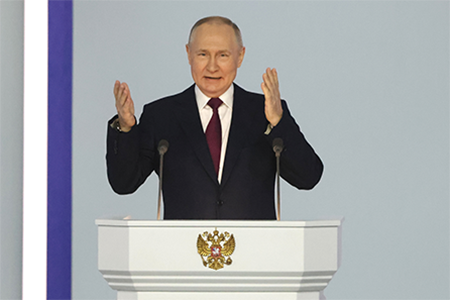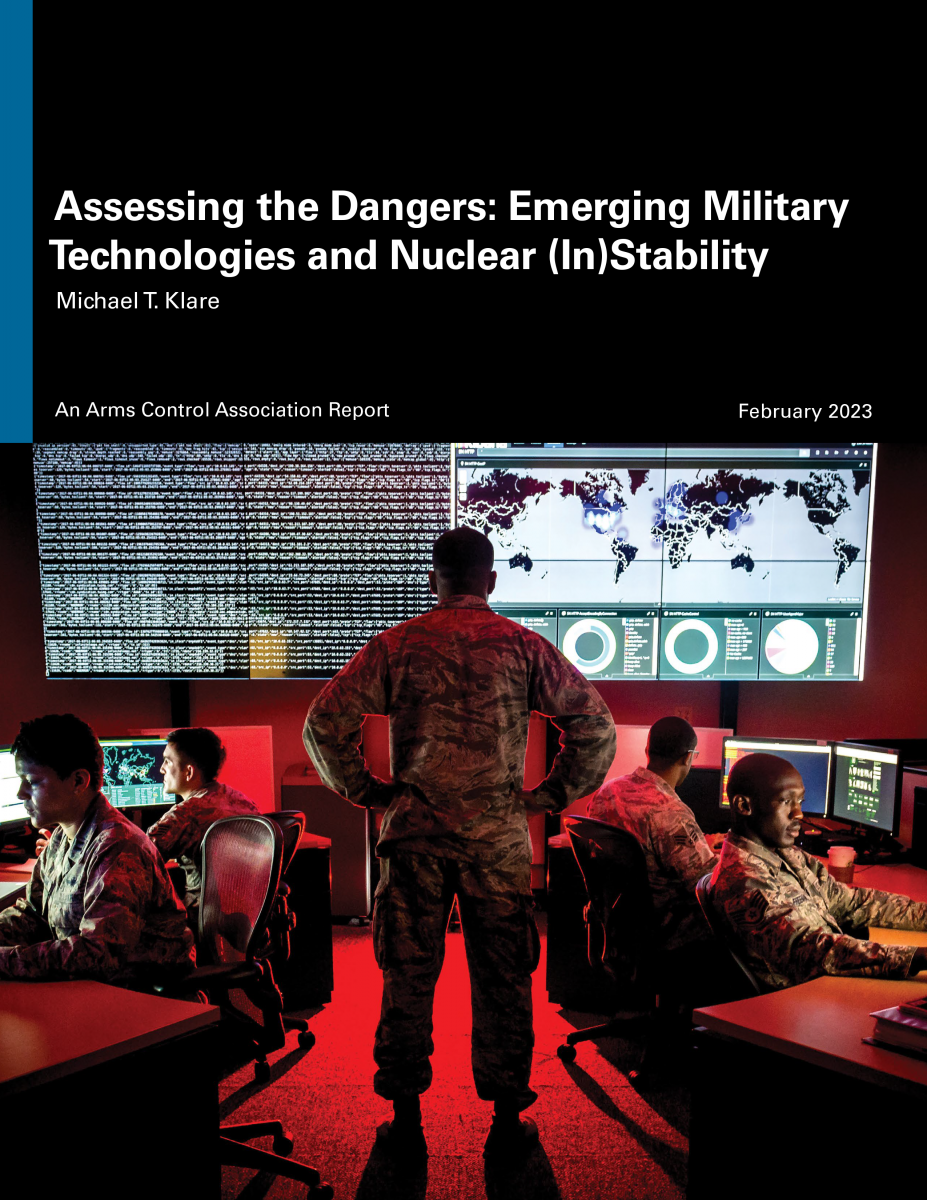Inside the Arms Control Association
March 2023
In a rambling Feb. 21 speech attempting to justify Russia's illegal invasion of Ukraine, Russian President Vladimir Putin announced his decision to “suspend” implementation of New START, the last remaining treaty limiting the world's two largest nuclear arsenals.
 While this does not mark the end of the treaty, Putin’s announcement makes it far more likely that, after New START expires Feb. 5, 2026, there will be no agreement limiting U.S. and Russian strategic nuclear arsenals for the first time since 1972.
While this does not mark the end of the treaty, Putin’s announcement makes it far more likely that, after New START expires Feb. 5, 2026, there will be no agreement limiting U.S. and Russian strategic nuclear arsenals for the first time since 1972.
Despite Russia’s failure to comply with New START inspections and data exchange obligations, Russia’s Ministry of Foreign Affairs has reaffirmed that Russia will, for now, continue to observe limits on the number of strategic nuclear warheads and delivery systems it can deploy under the treaty.
Notably, the Biden administration "remains ready to talk about strategic arms limitations at any time with Russia irrespective of anything else going on in the world or in our relationship."
Despite headwinds, there is still time, opportunity, and ample reason to prevent a bad situation from worsening.
Continued U.S. presidential leadership, stronger congressional support for commonsense nuclear limits, and added international pressure, could still convince the Kremlin to resume New START inspections and data exchanges and secure an agreement that both sides will respect the central limits set by New START until the two governments can conclude a new, more comprehensive nuclear arms control framework.
It Is Time to Act
As my colleague Frank von Hippel and I wrote in Scientific American last week, it is encouraging that many members of Congress support such an approach. But other members of Congress are calling for the United States to step away from New START, increase the size of the U.S. arsenal, and develop new types of nuclear weapons.
Now is the time for all of us to speak out against a new nuclear arms race.
A broad network of civil society organizations, including the Arms Control Association, is already working together to rally support for disarmament diplomacy. In a letter organized by ACA and sent this week to Congress, more than 35 prominent national organizations and former government officials encourage support of U.S. efforts to resume all activities under New START and engage in talks with Russia on a successor nuclear arms control arrangement.
We also encourage you to help pitch in by contacting your members of Congress. See this online action alert from the Physicists Coalition for Nuclear Threat Reduction.
Thanks for your past and future support.
Save the Date: ACA’s Annual Meeting Set for June 2
 Please mark June 2 on your calendar for our 2023 Annual Meeting at the National Press Club in Washington, D.C.
Please mark June 2 on your calendar for our 2023 Annual Meeting at the National Press Club in Washington, D.C.
Once again, the meeting will be in-person for registered guests; we will also simultaneously webcast the event for those who are unable to join us in Washington, D.C.
Details on the program, early registration, and more will be available soon on our website at ArmsControl.org/2023AnnualMeeting. We look forward to seeing ACA members, friends, colleagues, and special guests.
ACA Pushes Diplomatic “Plan B” on Iran’s Nuclear Program
Iran’s nuclear program made headlines again Feb. 20 after reports emerged that the International Atomic Energy Agency (IAEA) detected uranium particles enriched to 84 percent, which is just short of the 90 percent generally considered weapons grade.
A Feb. 28 IAEA report confirming the presence of 84 percent enriched uranium, said that discussions with Iran over the incident are ongoing and that Iran is not stockpiling uranium enriched to that level.
This incident, along with other developments since the United States pulled out of the 2015 Iran nuclear deal some four years ago, underscores the worsening proliferation risk of Iran’s rapidly expanding nuclear program.
 As ACA’s director for nonproliferation policy, Kelsey Davenport has warned, the situation is not sustainable, noting Iran’s “near-weapons-grade enrichment activity should raise alarm bells in the United States and Europe over the urgent need for diplomacy with Iran to de-escalate the growing nuclear crisis.”
As ACA’s director for nonproliferation policy, Kelsey Davenport has warned, the situation is not sustainable, noting Iran’s “near-weapons-grade enrichment activity should raise alarm bells in the United States and Europe over the urgent need for diplomacy with Iran to de-escalate the growing nuclear crisis.”
“Absent limits on Iran’s nuclear advances, escalation to military action or sabotage to address the proliferation risk appears almost inevitable. The United States and Europe cannot afford to simply continue pointing the finger at Tehran for derailing JCPOA negotiations in August 2022 while waiting for the country to come back to the negotiating table,” Davenport warns.
With prospects for a deal to restore mutual compliance with the Joint Comprehensive Plan of Action (JCPOA) dimming ACA is pushing the White House to act through energetic public and media outreach, direct meetings with senior U.S. officials, collaboration with other civil society experts and organizations, and briefings for congressional staff.
ACA is also outlining realistic options for how and what the United States and its European partners can do to reduce the risks and increase transparency into Iran’s activities. For more information see:
- “South Korean precedent could help resolve IAEA Iran safeguards probe,” How creative and flexible diplomacy can ensure that information is provided while giving Iran a face-saving path to cooperation. Commentary by Kelsey Davenport for Stimson Center, March 6.
- “The Iranian Nuclear Crisis: Time for Plan B,” by Kelsey Davenport, in Arms Control Today, December 2022
Thanks to Our Members and Donors!
We are especially grateful to our ACA members and donors who made our 50th Anniversary fundraising efforts a memorable success in 2022. You can view your contribution history online and print receipts for tax-deduction purposes by visiting ArmsControl.org/Update.
If you have any questions about your contributions and support, please contact Kathy Crandall Robinson at [email protected] or (202) 463-8270 ext. 101.
New Report on the Dangers of Emerging Military Tech to Nuclear (In)Stability
 From artificial intelligence, drones, cyber weapons, hypersonic missiles, and new offensive space capabilities, advanced military powers are incorporating new kinds or new applications of advanced technologies in their arsenals.
From artificial intelligence, drones, cyber weapons, hypersonic missiles, and new offensive space capabilities, advanced military powers are incorporating new kinds or new applications of advanced technologies in their arsenals.
A new ACA report by Senior Fellow Michael Klare, Assessing the Dangers of Military Technologies and Nuclear (In)Stability, examines four classes of new applications of technologies for military purposes and it proposes a framework strategy aimed for advancing an array of measures that all contribute to the larger goal of preventing unintended escalation and enhancing strategic stability.
ACA In the News
- Research associate Gabriela Rosa Hernández’s breaking Arms Control Today story on Russia’s violation of its obligations under the Vienna Document was cited by numerous Russian media outlets, as well as the Russian arms control delegation in Vienna, March 6.
- Executive Director Daryl Kimball was cited in a Forbes Mexico article on the fate of New START: “Más allá del Nuevo START: cómo mide EU el riesgo de un ataque nuclear ruso,” March 5
- ACA’s director for nonproliferation policy Kelsey Davenport discussed with Agence France Press why it is a “positive and necessary step” for Iran to agree to reconnect IAEA monitoring cameras, March 4.
- Board chair Thomas Countryman was interviewed on CTV News about Iran’s nuclear weapons program, March 2.
- Davenport authored “Iran’s nuclear program is advancing. So too should negotiations,” for the Atlantic Council’s Iran Source blog, March 2.
- Rosa Hernández spoke with Newsweek on the HIMARS and the M270 Multiple Rocket Launch System (MRLS) provided by the U.S. to Ukraine, March 2.
- Kimball and Frank von Hippel co-authored the op-ed “We Must Prevent a New Nuclear Arms Race: Smart U.S. leadership and international pressure on Russia can prevent an unconstrained global nuclear arms race,” in Scientific American, March 1.
- Davenport spoke with France24 News about the IAEA report that “Iran has uranium particles enriched to nearly bomb grade,” Feb. 28.
- Davenport was cited extensively in a CNN report on the nonproliferation risks posed by Iran’s uranium enrichment program, Feb. 28.
- Kimball spoke with the Associated Press about the significance reports that uranium particles enriched to 84% U-235 levels were detected in Iran, Feb. 24.
- ACA Senior Fellow Jeff Abramson commented in Responsible Statecraft how “New Biden arms sale policy puts human rights abusers on notice,” Feb. 23.
- Kimball was quoted in a Los Angeles Times news analysis on “Putin leaving nuclear treaty,” Feb. 22.
- ACA’s criticism of Putin’s decision to “suspend” Russian implementation of New START was reported by El Pais Costa Rica, Feb. 21.
- Kimball provided detailed comments and analysis for a Foreign Policy “explainer” on “Putin’s New START Announcement and the Future of Arms Control,” Feb. 21.
- Executive director Daryl Kimball reacted in the Wall Street Journal to the news that “Putin Suspends Nuclear-Arms Treaty Between Russia, U.S.,” Feb. 21.
- Senior fellow Michael Klare discussed with Breaking Defense how “DoD’s clarified AI policy flashes ‘green light’ for robotic weapons,” Feb 9.
- NPR’s Michelle Kelemen reported on ACA's recent webinar in “U.S. says Russia is violating nuclear treaty,” Feb 2.

